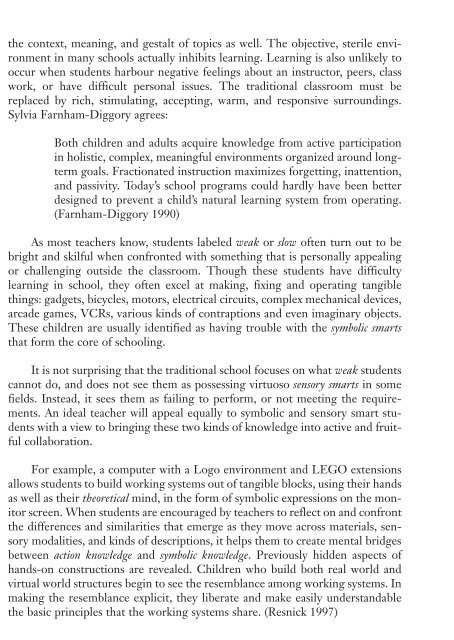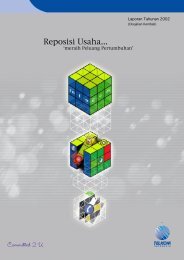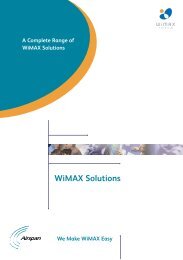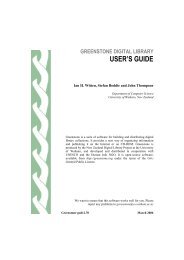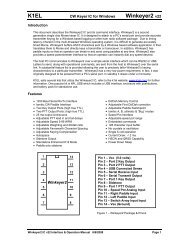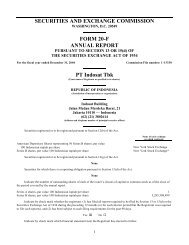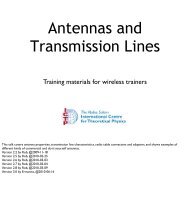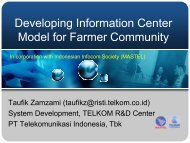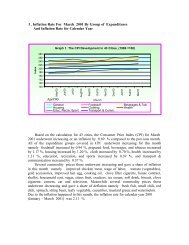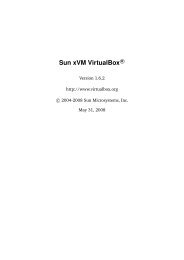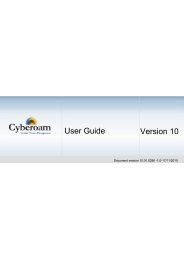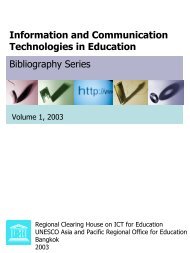Information and communication technologies in schools: a ...
Information and communication technologies in schools: a ...
Information and communication technologies in schools: a ...
Create successful ePaper yourself
Turn your PDF publications into a flip-book with our unique Google optimized e-Paper software.
the context, mean<strong>in</strong>g, <strong>and</strong> gestalt of topics as well. The objective, sterile environment<br />
<strong>in</strong> many <strong>schools</strong> actually <strong>in</strong>hibits learn<strong>in</strong>g. Learn<strong>in</strong>g is also unlikely to<br />
occur when students harbour negative feel<strong>in</strong>gs about an <strong>in</strong>structor, peers, class<br />
work, or have difficult personal issues. The traditional classroom must be<br />
replaced by rich, stimulat<strong>in</strong>g, accept<strong>in</strong>g, warm, <strong>and</strong> responsive surround<strong>in</strong>gs.<br />
Sylvia Farnham-Diggory agrees:<br />
Both children <strong>and</strong> adults acquire knowledge from active participation<br />
<strong>in</strong> holistic, complex, mean<strong>in</strong>gful environments organized around longterm<br />
goals. Fractionated <strong>in</strong>struction maximizes forgett<strong>in</strong>g, <strong>in</strong>attention,<br />
<strong>and</strong> passivity. Today’s school programs could hardly have been better<br />
designed to prevent a child’s natural learn<strong>in</strong>g system from operat<strong>in</strong>g.<br />
(Farnham-Diggory 1990)<br />
As most teachers know, students labeled weak or slow often turn out to be<br />
bright <strong>and</strong> skilful when confronted with someth<strong>in</strong>g that is personally appeal<strong>in</strong>g<br />
or challeng<strong>in</strong>g outside the classroom. Though these students have difficulty<br />
learn<strong>in</strong>g <strong>in</strong> school, they often excel at mak<strong>in</strong>g, fix<strong>in</strong>g <strong>and</strong> operat<strong>in</strong>g tangible<br />
th<strong>in</strong>gs: gadgets, bicycles, motors, electrical circuits, complex mechanical devices,<br />
arcade games, VCRs, various k<strong>in</strong>ds of contraptions <strong>and</strong> even imag<strong>in</strong>ary objects.<br />
These children are usually identified as hav<strong>in</strong>g trouble with the symbolic smarts<br />
that form the core of school<strong>in</strong>g.<br />
It is not surpris<strong>in</strong>g that the traditional school focuses on what weak students<br />
cannot do, <strong>and</strong> does not see them as possess<strong>in</strong>g virtuoso sensory smarts <strong>in</strong> some<br />
fields. Instead, it sees them as fail<strong>in</strong>g to perform, or not meet<strong>in</strong>g the requirements.<br />
An ideal teacher will appeal equally to symbolic <strong>and</strong> sensory smart students<br />
with a view to br<strong>in</strong>g<strong>in</strong>g these two k<strong>in</strong>ds of knowledge <strong>in</strong>to active <strong>and</strong> fruitful<br />
collaboration.<br />
For example, a computer with a Logo environment <strong>and</strong> LEGO extensions<br />
allows students to build work<strong>in</strong>g systems out of tangible blocks, us<strong>in</strong>g their h<strong>and</strong>s<br />
as well as their theoretical m<strong>in</strong>d, <strong>in</strong> the form of symbolic expressions on the monitor<br />
screen. When students are encouraged by teachers to reflect on <strong>and</strong> confront<br />
the differences <strong>and</strong> similarities that emerge as they move across materials, sensory<br />
modalities, <strong>and</strong> k<strong>in</strong>ds of descriptions, it helps them to create mental bridges<br />
between action knowledge <strong>and</strong> symbolic knowledge. Previously hidden aspects of<br />
h<strong>and</strong>s-on constructions are revealed. Children who build both real world <strong>and</strong><br />
virtual world structures beg<strong>in</strong> to see the resemblance among work<strong>in</strong>g systems. In<br />
mak<strong>in</strong>g the resemblance explicit, they liberate <strong>and</strong> make easily underst<strong>and</strong>able<br />
the basic pr<strong>in</strong>ciples that the work<strong>in</strong>g systems share. (Resnick 1997)<br />
Schools <strong>in</strong> Transition<br />
111


